Systemic changes necessary to achieve gender equality in Japan
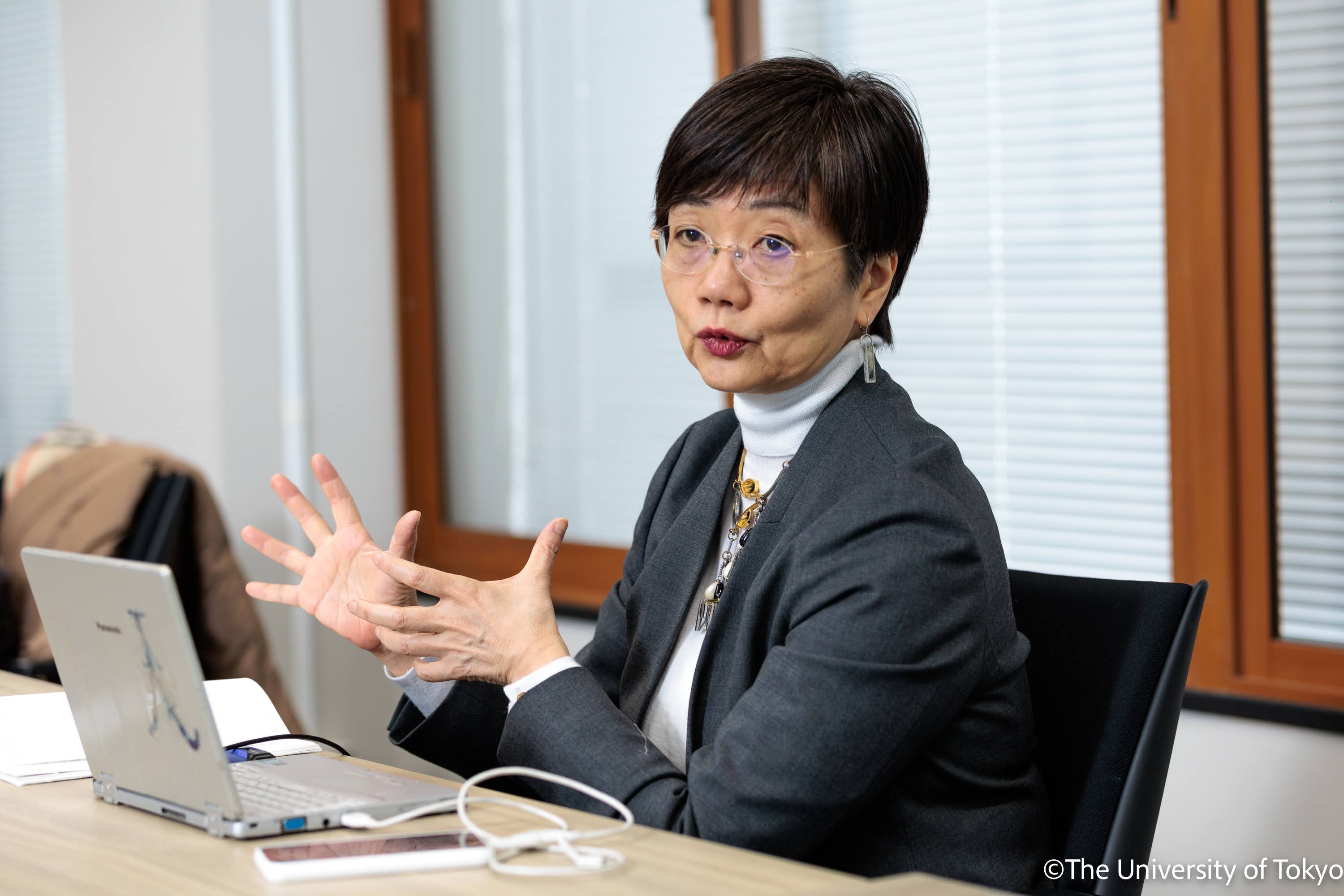
March 8 is International Women’s Day, celebrated annually by the United Nations and around the world to highlight ongoing issues concerning women’s rights and participation in political and economic spheres. Professor Yuki Honda of the Graduate School of Education at the University of Tokyo, who conducts research on the relationship between education, work and family, discusses gender inequality in Japan and how we can overcome it.

―― What is important to keep in mind as we celebrate International Women’s Day?
It is extremely important that we shine the spotlight on women, who tend to be considered secondary to men. There are a few points to keep in mind, however, before discussing women and gender. In contrast to “sex,” which is a biological concept, the term “gender” refers to a socially and historically constructed concept. Within this concept, we also find the gender-based, normative expectations of how women and men should behave on the basis of perceived, essential differences between them. Also known as gender norms, these socially and historically constructed ideas were shared among people and have become internalized. However, as numerous gender-focused studies have pointed out, the kind of language and thinking that divides us into the binary categories of “female” and “male” can be harmful. For example, this results both in the exclusion of gender minorities, who may not necessarily fit into either of these categories, as well as the erasure of distinctions and diversity within the two categories themselves.
In order for us to foster diversity, I believe we should ultimately reevaluate and eliminate language and biases that are based in this binary view of the world. On the other hand, distribution data shows a large gap between women and men that places women at a clear disadvantage. Therefore, given the current situation, we perhaps have little choice but to use categories like “female” and “male” as part of the process of eliminating binary thinking. While it is indeed very important that we focus on women in celebrating International Women’s Day, I feel we should also be aware that we are still in the process of eliminating gender inequality.
Biases in Japanese society
―― What is the current state of gender inequality in Japan?
The World Economic Forum publishes an annual report evaluating the current status of the gender gap based on data from various countries. In the 2023 report, Japan’s gender gap index was ranked 125th out of 146 countries. This is the worst result for Japan since the report was first published in 2006, and it is unbefitting a country that considers itself a developed nation. We need to take a closer look at the specific factors being evaluated.
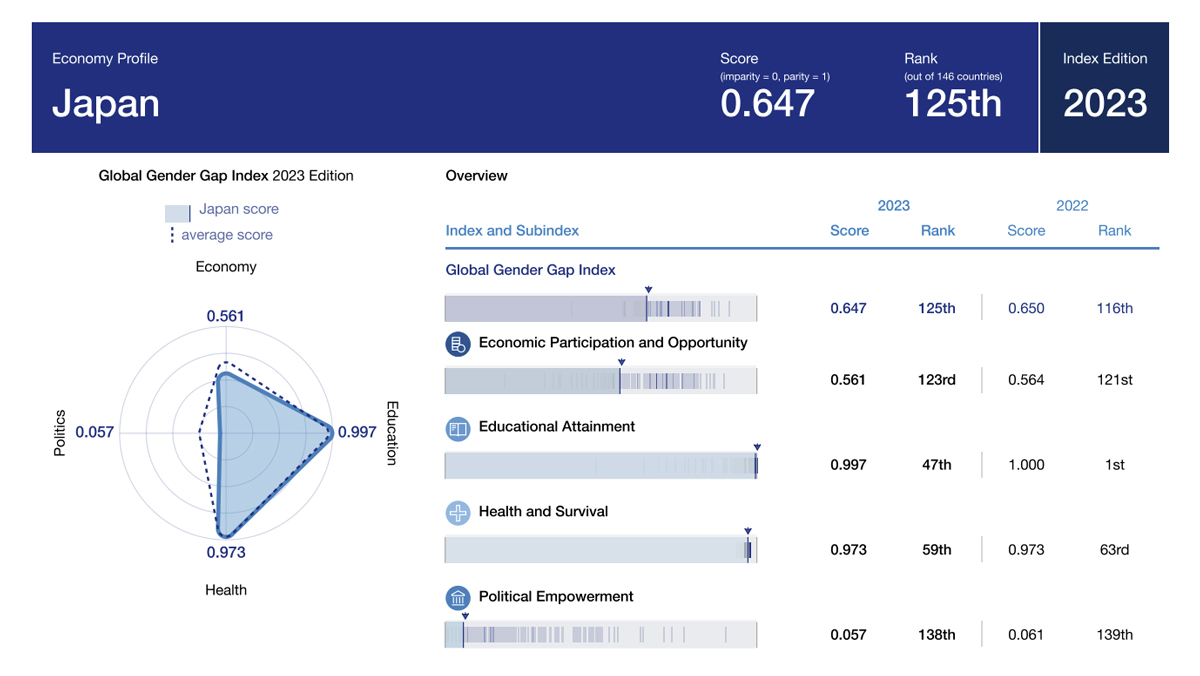
First of all, the largest factor in Japan’s low ranking is its level of political empowerment. In addition to the incredibly low number of women in political decision-making positions at both local and national levels, the average age of parliament members is the highest among developed nations. In other words, the voices of women and young people go largely unheard because the people who create laws and systems are mainly older men.
Second, Japan’s gender gap with relation to economic participation and opportunity is another factor in the country’s low ranking. This can be attributed to the disparity between regular and nonregular employment. In Japan, there is a large difference in wages between regular and nonregular workers. Not only are the latter paid less, but they are treated as disposable and useful only when needed, and their skill development is neglected. If you only look at the employment rate, it would appear that gender equality has been achieved; but the majority of women are employed in nonregular positions in order to balance family and work. This means that the proportion of women in managerial and highly specialized positions is lower, thus hindering their economic participation and opportunity.
Another factor to examine closely is educational attainment. The published gender gap index in education does not include gender disparities by field in its indicators; therefore, the index gives the impression that gender equality has been achieved in Japan. However, when you take a closer look at university faculties and majors, you see that the proportion of women studying science and engineering is incredibly small compared to fields like nursing and the humanities. This is a manifestation of the “masculine” and “feminine” gender stereotypes that have permeated society. As demonstrated by the results of the Programme for International Student Assessment (PISA), which surveys 15-year-olds in numerous countries and regions worldwide, science and mathematics literacy among Japanese girls is among the highest. The fact that so few of them go on to higher education in science and engineering, despite such a high level of literacy, reflects societal assumptions about which academic fields are appropriate for what gender.
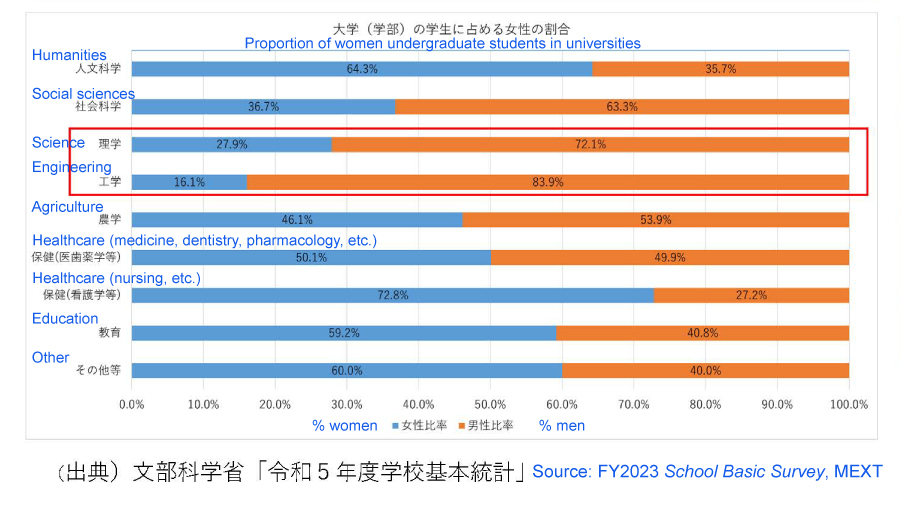
The chart shows the percentages of women undergraduate students, compared to men, in various Japanese university departments. The proportion of women is lowest in science and engineering.
|
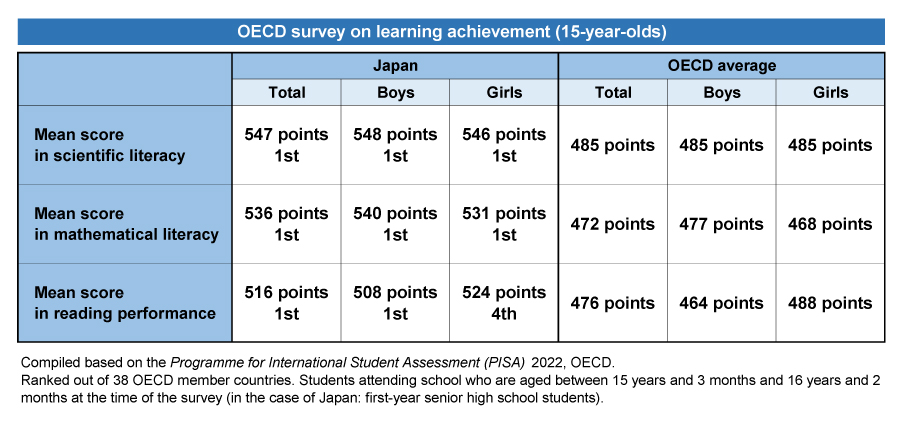
Educational performance of Japanese 15-year-olds (first-year high school students) in the PISA 2022 assessment, conducted by the Organization for Economic Co-operation and Development (OECD). In scientific and mathematical literacy, Japanese girls — as well as boys — outperformed their peers in other OECD member countries.
*Both figures sourced from Current Status and Challenges of Gender Equality in Japan (Gender Equality Bureau Cabinet Office, March 2024) (Japanese version); English terminology based on that of Current Status and Challenges of Gender Equality in Japan (Gender Equality Bureau Cabinet Office, May 2022) (English version) |
―― Why are gender stereotypes so difficult to dispel?
As I mentioned earlier, there are gender gaps in political empowerment and economic participation and opportunity, and in order to fix these gaps, it is important that we reform the social structure centered on older men and increase the proportion of women in all areas. But it is also necessary for individuals to recognize that even their personal decisions are influenced by the gender stereotypes prevalent in society, so change needs to happen at the individual level, too.
Women are not the only ones forced to live in difficult circumstances as a result of these stereotypes. Men, for instance, have been required to pour most of their time and energy into work, to fulfill public roles outside the home and to earn an income; but we know from attitude surveys that many men would like to spend more time on activities other than work. However, Japanese society has long maintained a gender stereotype that men are to be breadwinners, and both women and men have become accustomed to this imbalance. In order for men to maintain power and financial resources, they expected women to take on roles they did not fill, and as a result, housework was forced onto women. This in turn led women to expect men to work and earn money. Neither group has been able to break free of this asymmetrical situation, resulting in its replication and perpetuation. That is where Japan stands today.
Addressing the perpetuation of gender inequality
―― How did gender inequality in Japan historically take shape?
If we look at the social circulation model of postwar Japan that was constructed in the period of economic growth following the nation’s defeat in World War II, we can understand the root causes behind society’s asymmetry. This model describes a society in which resources flow in one direction between education, work and family. During the 1960s, Japan underwent a period of rapid economic growth, technological innovation and rising incomes. The government took the initiative in creating a social system to respond to these changes and directed people to undertake three social systems according to their gender and age: education, work and family. It was imagined that if children focused on their studies, men on work and women on supporting the family, performance in each area would reach its maximum potential. As a result, from the 1960s through the 1980s, the gender division of labor was incorporated as an essential mechanism of the circulation model. Though the model is seemingly efficient, it not only reinforced gender stereotypes, but it also worked to undermine the fundamental significance of each of the three social systems.
Additionally, in the early 1970s, the oil crisis struck just as Japan was taking steps to enhance its pension system and establish a welfare state. The resulting decline in tax revenue rocked the country’s financial foundations, leading the government to instead put forth the idea of a “Japanese-style welfare society.” Instead of a typical welfare state, in which the welfare system is maintained through taxes collected by the government, the Japanese-style welfare society keeps spending to a minimum and people’s livelihoods are supported by encouraging self-help efforts and familial support. At the core of this type of society is an imagined, idealized family unit that the government tried to create by imposing self-serving roles and expectations onto women. Women were expected to be the primary caretakers of children and the elderly in the family, and this was treated as though it were simply a “beautiful” Japanese custom.
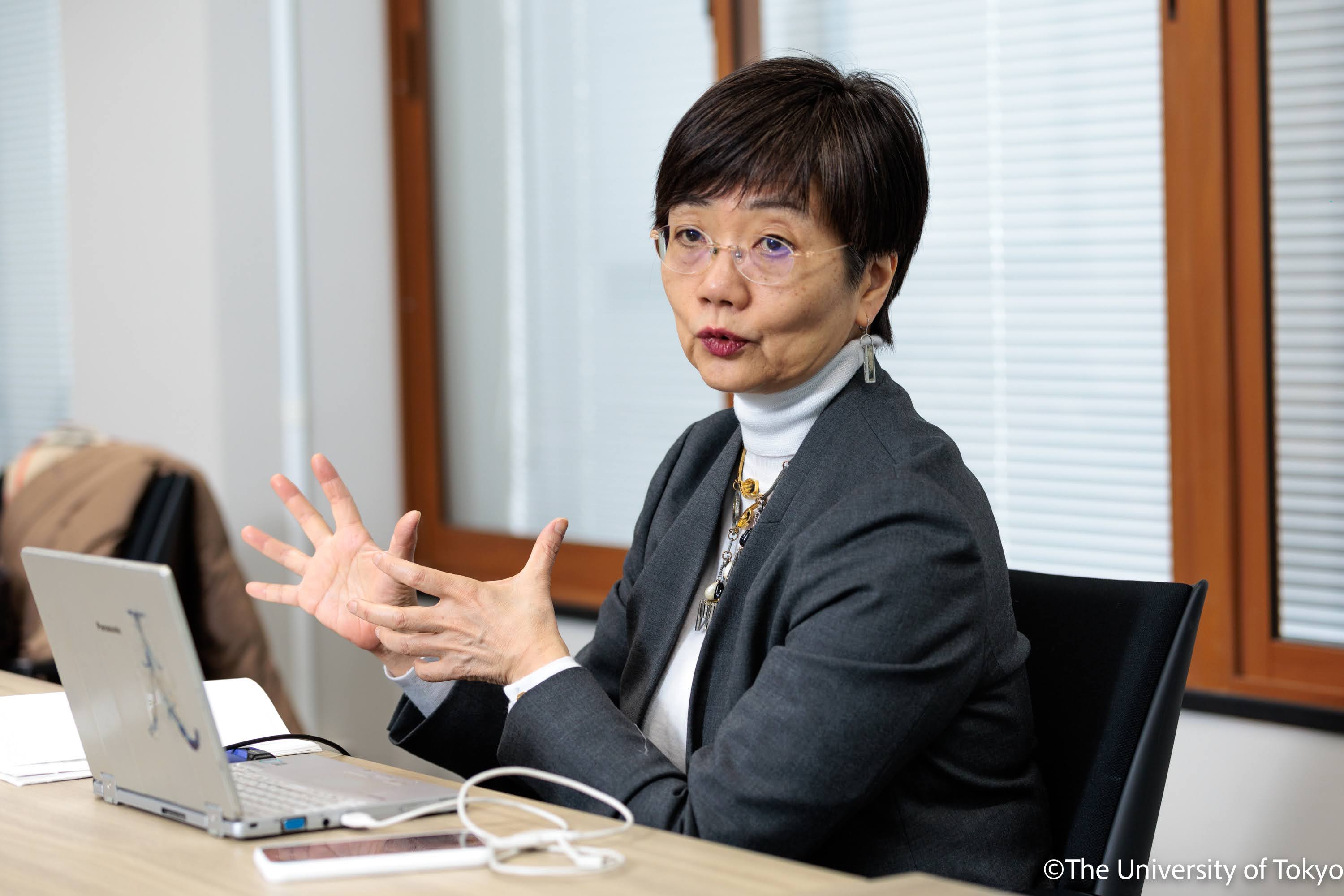
There have been periods with clear gender divisions of labor in other Western developed nations, as well. In many of those nations, after the they moved beyond such a period of labor division, efforts to improve the situation gradually spread, leading to better circumstances for women in various public spheres. In comparison, the struggle to overcome the situation in Japan has not quite gotten off the ground. The fantasies of the social circulation model and the Japanese-style welfare society dominate the public imagination, and they are remembered as success stories of Japan’s period of economic growth, making it difficult to bring about change to the gender balance issue. Since the collapse of the economic bubble in the early 1990s, the social circulation model has been heading toward the breakdown of the relationship between the three social systems of education, work and family. The birthrate is falling, the population is both shrinking and aging, wages are stagnant, and the number of people in need is rapidly increasing — the Japanese-style welfare society is failing. In order to ensure a functioning society in the future, we need to see change in the gender balance issue more than ever.
―― What efforts do you think are necessary to fix the gender balance issue?
I think we need to see drastic and substantial changes in society as a whole that reconnect the divisions between education, work and family. This is not something that can be achieved by any single law or policy — enacting change of this magnitude requires the complete realignment of each of these social systems. First, it is important that we reform the way that we work in order to create a society in which women and men alike can work appropriate hours and lead healthy private lives. I feel that by doing so, women should be able to participate in society with as much political influence and economic power as possible. To that end, we must create a society in which care work, which had been previously the responsibility of women, can be handled outside the household. In addition to caring for the elderly, another important factor is the expansion of child care and education. There’s a term that I have heard in recent years, “the parent lottery,” which describes how one’s lot in life is affected by the familial environment one is born into by chance. If public institutions can take on the care and education of children outside the home in a way that is more fulfilling in terms of both quality and quantity than the current situation, we will be able to mitigate the effects of this “lottery.”
Institutions of higher education also have a responsibility to promote women’s political and economic empowerment. At the University of Tokyo, efforts are being made every day to fix the gender balance issue, but they are still far from being sufficient. I believe it is important to constantly self-examine to ensure that we do not reproduce gender biases, and to continue our efforts to nurture talent, regardless of gender, to play important roles in society.
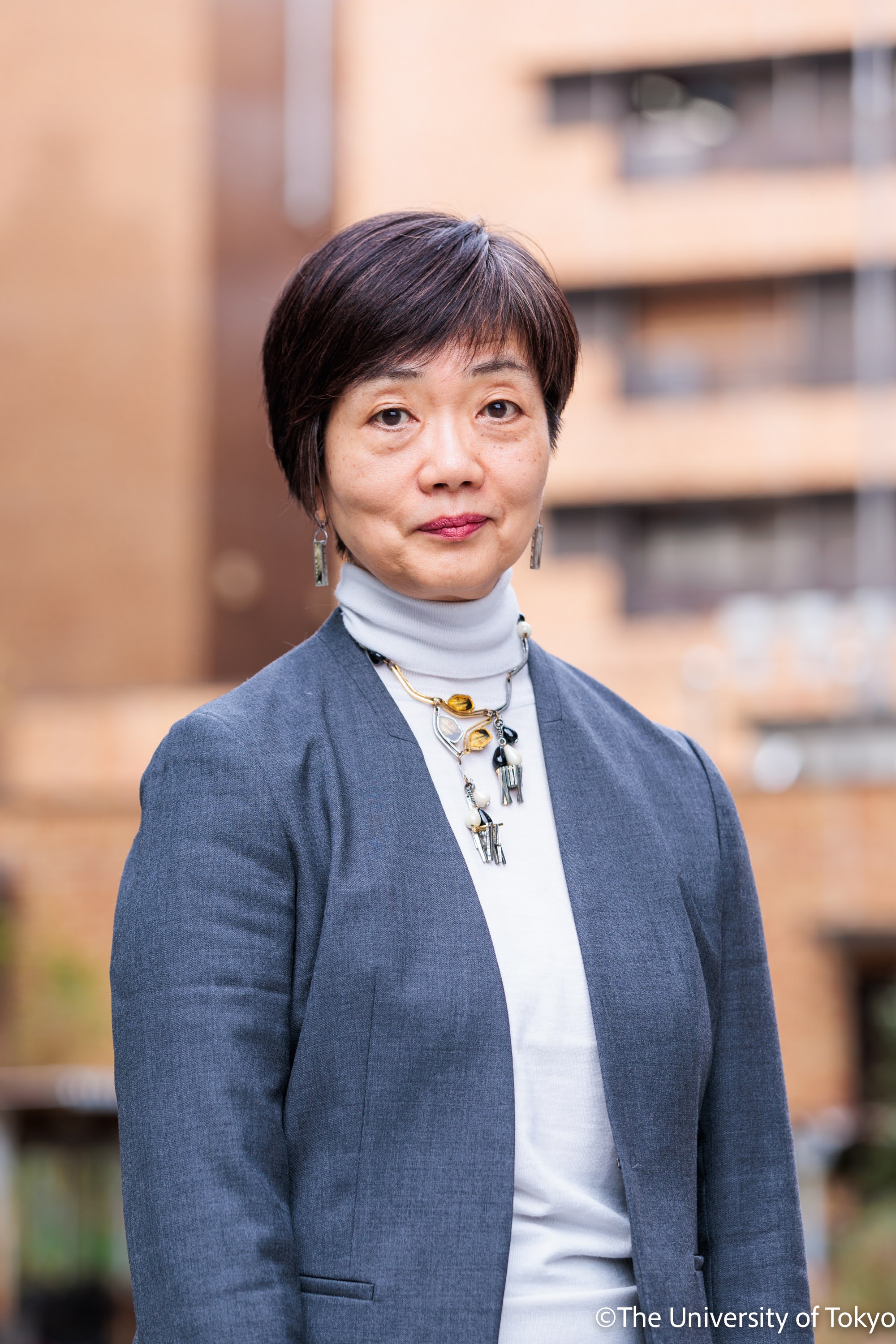
Yuki Honda
Professor, Graduate School of Education
Ph.D. in education from the Graduate School of Education at the University of Tokyo. Assumed current position in 2008 after serving as a researcher in the Japan Institute for Labour, and assistant professor in the Institute of Social Science at the University of Tokyo, among other positions. Author of numerous publications in Japanese, including Kyōiku wa nani o hyōka shite kita no ka (“What has education valued?”) (Iwanami Shoten, Publishers, 2020) and “Nihon” tte donna kuni? (“What’s ‘Japan’?”) (Chikumashobo, 2021), and a contributing author to Education in Japan (Springer Singapore, 2019) published in English.
Interview date: Jan. 11, 2024
Interview: Yuki Terada, Hannah Dahlberg-Dodd






